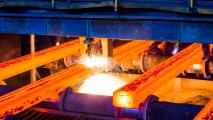The United States’ reliance on China for rare earth elements could soon come to an end, thanks to a new process that pulls the valuable metals from the ash left over when we burn coal.
Why it matters: The 17 rare earth elements aren’t actually rare — they’re all more common than gold, and one is more abundant than copper. But getting our hands on them is difficult because they’re widely dispersed in Earth’s crust and hard to extract through mining.
That’s a problem because we need rare earth elements to make a lot of products, from smartphones and satellites to electric cars and wind turbines.
A vulnerable position: For the past decade, the U.S. has imported about 80% of its annual supply of rare earth elements from China. That dependence is unsettling given that China temporarily withheld the minerals from Japan in 2010, in response to an unrelated dispute.
“Japan experienced what the U.S. faces now: a political conflict with China, in which China seems to be willing to exploit its dominance in the [rare earths] market,” Marc Schmid, an economist at the Martin Luther University Halle-Wittenberg, wrote in 2019.
“We have mountains — literal mountains — of fly ash in the United States.”
James Tour
The idea: Rice University researchers have now developed a process that makes it easier to extract rare earth elements from fly ash, which is the byproduct of coal-fired power plants.
“We have mountains — literal mountains — of fly ash in the United States from all these years of burning coal, and it doesn’t have much utility,” chemist James Tour explained.
Researchers have long known that fly ash contains rare earth elements, but they’re encased in a glass that makes extracting them difficult — the standard process involves strong acids that are not environmentally friendly.
Tour’s team has now demonstrated that a process called “flash Joule heating,” which it developed to produce graphene, can be used to extract rare earth elements from fly ash, too.
This process heats the fly ash to 5,432 degrees Fahrenheit in a second to break the glass. Using a very mild acid, the researchers could then extract twice as much of the rare earth elements as they could with a strong acid without the flash heating.
“We’re no longer dependent on environmentally detrimental mining or foreign sources for rare earth elements.”
James Tour
The big picture: Less than a week after the Rice researchers published their study, the U.S. Department of Energy asked for input on how to build a $140 million facility capable of extracting rare earth elements and other valuable materials from fossil fuel waste.
It’s too soon to say whether Rice’s process will be utilized there, but it sure seems like the kind of technology the facility will need — and Tour sounds ready and willing to make it available.
“The Department of Energy has determined this is a critical need that has to be resolved,” he said. “Our process tells the country that we’re no longer dependent on environmentally detrimental mining or foreign sources for rare earth elements.”
We’d love to hear from you! If you have a comment about this article or if you have a tip for a future Freethink story, please email us at [email protected].






